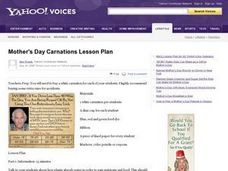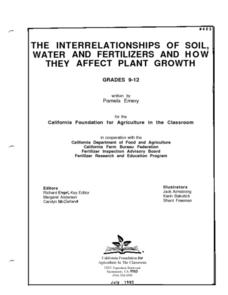Curated OER
What Happens to the Food You Eat? The Digestive System
Students observe a video displaying body parts and functions of the digestive system. They make drawings of the digestive system from their observations. They act out a short play involving body parts.
Curated OER
How Much Water is in That River?
Students practice measurement using the Hudson River. They calculate the discharge measurement at a location on the Hudson River using ingenuity and a topographic map.
Curated OER
Protists - The Protozoans
Five pages provide thorough coverage of three protozoans: euglena, amoebae, and paramecia. For each, junior biologists read factual text, label the organism, and write answers to several questions. This neatly organized assignment is...
Curated OER
How Does Your Garden Grow?
Young gardners read and listen to books about seeds, plants, and the growing process. They plant seeds in plastic cups to observe the process of root-growing and plant formation. The whole class walks through a field to collect seeds...
Curated OER
A Hidden Beauty
Expose the beautiful mystery of bulbs as young botanists learn all about these fascinating plants. They glean information from a short text before observing actual bulbs (consider an onion), and comparing their findings with predictions....
Utah Education Network (UEN)
Balanced Diet
Second graders investigate the concept of a balanced diet and how the food pyramid is organized. They conduct research using the links included in the instructional activity. They differentiate the parts of the pyramid while looking at...
Captain Planet Foundation
Rotting Away
What happens at the end of a plant's life cycle? Show kids the natural way that plants show that they're decomposing, as well as the importance of compost, with a lesson about living organisms. After reading Log Cabin by Anne Schreiber,...
Curated OER
Finding Fungi in the World Around Us
These lesson ideas will help your students explore the diversity of Kingdom Fungi.
Curated OER
Nutrition
Students explore nutrition. In this science lesson plan, students identify and describe the main nutrients in our diets that are needed by the body as a source of energy.
Curated OER
Meat, Poultry, Fish, Eggs: Constructing and Maintaining
Students investigate meat as a source that provides protein, iron and nutrients in the diet. They identify types of meat and their sources, complete a market survey, conduct a fried egg experiment, and prepare various recipes that...
Science Teachers
Organ Systems Crossword Puzzle
An attractive and informative body systems crossword plus its answer key is provided for your life science learners. The topic is the organs. With 23 prompts to address, they are sure to get a complete review in identifying the systems...
Curated OER
Eggs: A Practical Application
Students examine the chemical and physical nature of eggs and their role in food preparation.
K12 Reader
Tissues, Organs and Systems
Young scientists are introduced to the connections among cells, tissues, organs, and systems in a life science reading comprehension worksheet that asks them to respond to a series of questions based on the passage.
Curated OER
Get the Skinny on Milk
Students identify the different types of milk available in the market. In this adult health science lesson, students compare their nutrition information. They read milk labels and analyze the nutrients in it.
Curated OER
The Human Organism
In this digestion and nutrition lesson, 3rd graders test foods to find their vitamin content. Students test for starch and fats then compare their findings on charts and oral reports. The lesson concludes with a teacher directed...
Curated OER
Fruits and Vegetables
Students make a variety of recipes that include fruits and vegetables. For this fruit and vegetables lesson plan, students make recipes, learn about the proper amounts of fruits and vegetables needed per day, describe how to sanitize...
Curated OER
Why is Rice Good for Us?
Third graders explore why rice is good for our bodies. In this nourishment lesson plan, 3rd graders review the food pyramid and discuss serving sizes. Students discuss the different ways rice is used in food. Students use uncooked rice...
Curated OER
Mother's Day Carnations
Students make a carnation craft wtih a carnation, food dye, ribbon, dixie cup, and more. In this carnation lesson plan, students make this craft for Mother's Day.
Curated OER
The Interrelationships of Soil, Water and Fertilizers and How They Affect Plant Growth
Students examine how different nutrients in the soil and fertilizers affect plant growth. In groups, they participate in a role play in which allows them to see the interactions of humans and plants. They also read articles and record...
Curated OER
Mission Meals
High schoolers engage in a investigation of the types of meals that astronauts eat in space while examining the types of nutritional elements needed for optimum physical tasks in space. They are given different foods and then document...
Curated OER
Water
Students examine water, its function and how much you should consume. In this water lesson students study water and why it is important, how much you should drink and what its functions are in your body.
Curated OER
Food Pyramid Lab
Third graders complete a lab to review the Food Guide Pyramid and prepare a food item using all of the food groups.
Curated OER
S-O-I-L Soil
Fifth graders research soil, its nutrients, and plant growth. In this soil lesson plan, 5th graders create soil journals, trace flowers, and include nutrient information on each petal. Students read an excerpt from "McBroom Tells the...
Curated OER
Transportation System of a Tree
Students examine the transportation system of a tree and the speed with which nutrients and water move. Cross sections of the samples used are examined in class for experimental results.























